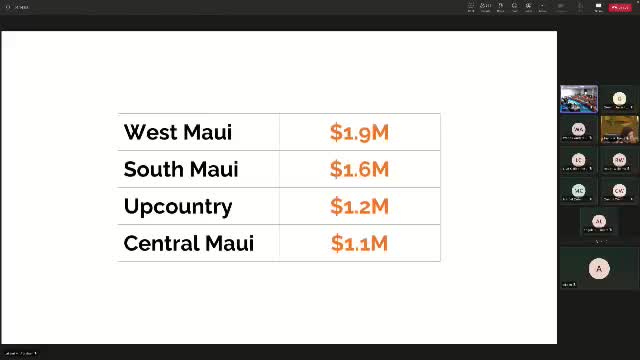Maui County proposes Bill 9 to phase out transient vacation rentals for housing
June 09, 2025 | Maui County, Hawaii
This article was created by AI summarizing key points discussed. AI makes mistakes, so for full details and context, please refer to the video of the full meeting. Please report any errors so we can fix them. Report an error »

Maui County is facing a severe housing crisis, with median home prices soaring to $1.9 million in West Maui and $1.6 million in South Maui, making homeownership unattainable for most local families. During a recent Housing and Land Use Committee meeting, officials highlighted that less than 10% of home sales in the past five years have been affordable for the median family, a stark contrast to the 50-70% affordability seen in the 1980s and 1990s.
The committee discussed Bill 9, which proposes to phase out 6,000 transient vacation rentals (TVRs) to convert them into resident housing. This initiative aims to address the critical shortage of affordable homes, particularly in areas where the housing crisis is most acute. Currently, only 40% of newly constructed homes in West and South Maui are occupied by residents, with the majority being used as vacation rentals.
The urgency of this bill is underscored by the fact that it would take decades to build enough new homes to meet the demand at current construction rates. For instance, it would take 79 years to build the equivalent number of homes in South Maui if only 40% are occupied by residents. In contrast, the proposed phase-out of TVRs could provide immediate housing solutions.
Data presented during the meeting revealed that Maui County has approximately 13,000 TVRs, which constitute 21% of the housing supply. This is significantly higher than other major tourist destinations, where TVRs account for only 1-3% of housing. The committee emphasized that reducing the number of TVRs would not only increase the availability of homes for residents but also help restore a more balanced visitor-to-resident ratio, aligning with the Maui Island Plan.
The meeting concluded with a call to action, stressing that housing should not be treated as a speculative asset but as a fundamental need for the community. The proposed measures aim to create a more sustainable housing market that prioritizes the needs of local families, ensuring that future generations can afford to live in their own communities.
The committee discussed Bill 9, which proposes to phase out 6,000 transient vacation rentals (TVRs) to convert them into resident housing. This initiative aims to address the critical shortage of affordable homes, particularly in areas where the housing crisis is most acute. Currently, only 40% of newly constructed homes in West and South Maui are occupied by residents, with the majority being used as vacation rentals.
The urgency of this bill is underscored by the fact that it would take decades to build enough new homes to meet the demand at current construction rates. For instance, it would take 79 years to build the equivalent number of homes in South Maui if only 40% are occupied by residents. In contrast, the proposed phase-out of TVRs could provide immediate housing solutions.
Data presented during the meeting revealed that Maui County has approximately 13,000 TVRs, which constitute 21% of the housing supply. This is significantly higher than other major tourist destinations, where TVRs account for only 1-3% of housing. The committee emphasized that reducing the number of TVRs would not only increase the availability of homes for residents but also help restore a more balanced visitor-to-resident ratio, aligning with the Maui Island Plan.
The meeting concluded with a call to action, stressing that housing should not be treated as a speculative asset but as a fundamental need for the community. The proposed measures aim to create a more sustainable housing market that prioritizes the needs of local families, ensuring that future generations can afford to live in their own communities.
View full meeting
This article is based on a recent meeting—watch the full video and explore the complete transcript for deeper insights into the discussion.
View full meeting
